Table of Contents
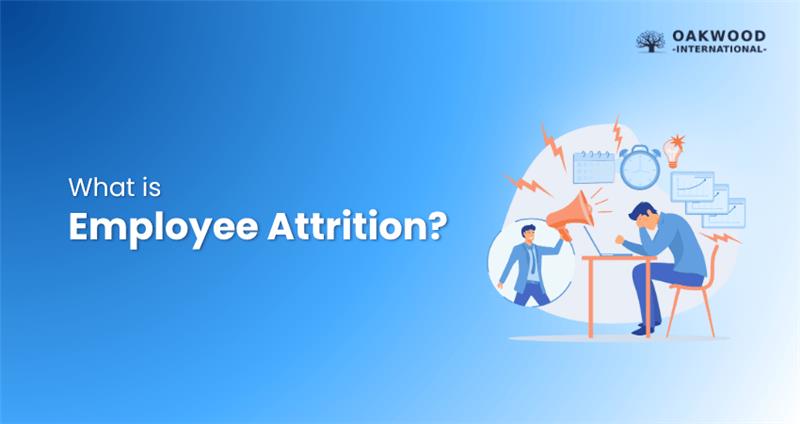

Employee Attrition is like losing key team members one by one, creating skill gaps and lowering morale. In a small startup, for example, if key players resign without being replaced, the remaining team often feels overwhelmed. This can lead to reduced productivity, increased hiring and training costs, and ultimately slow down business growth.
In this blog, we’ll explore what Employee Attrition really means, how it impacts Human Resources (HR), and the various types and causes behind it. We’ll also explain how to calculate attrition rates and share practical strategies to reduce turnover and build a stronger, more stable workforce.
Table of Contents
What is Employee Attrition?
Why is Employee Attrition Important for HR Leaders?
What are the Various Types of Employee Attrition?
What are the Common Causes of Employee Attrition?
What are the Four Key Factors Influencing Attrition?
What Does Employee Attrition Rate Mean?
Steps to Calculate the Employee Attrition Rate
Strategies to Reduce Attrition and Strengthen Company Culture
Conclusion
What is Employee Attrition?
Employee Attrition refers to the gradual reduction of a company’s workforce due to reasons like resignations, retirements, or layoffs, where roles are not replaced. Unlike turnover, attrition leads to a permanent decrease in staff.
While some attrition is natural, excessive attrition can create skill gaps, lower productivity, and increase hiring costs. HR teams need to monitor attrition rates, understand their causes, and develop strategies to manage them, ensuring the company’s stability and growth.
Why is Employee Attrition Important for HR Leaders?
For HR leaders, tracking and understanding attrition is more than just a numbers game. It reveals hidden organisational challenges, shapes smarter retention efforts, and strengthens long-term talent strategies. Here’s why it matters:
1. Identifies Underlying Workplace Issues
When employees consistently leave, it may indicate deeper problems such as ineffective leadership, limited growth opportunities, or a toxic work environment.
2. Helps Shape Better Retention Plans
By understanding why employees exit, HR can design strategies that improve retention. This may include enhancing benefits, supporting career development, or adopting flexible work models.
3. Improves Recruitment and Onboarding
Attrition data shows whether hiring aligns with long-term fit. HR teams can use this insight to refine job roles, improve interviews, and strengthen onboarding programs.
4. Reduces Long-term Hiring and Training Costs
High turnover is costly. Lowering attrition leads to fewer new hires and reduced training time. It also allows HR to focus on developing internal talent instead of constantly filling gaps.
5. Reflects Team Morale and Engagement
A spike in attrition often signals falling morale. By tracking exit patterns, HR can take proactive steps like boosting recognition, gathering feedback, and improving communication.
6. Aids Workforce and Succession Planning
Understanding where turnover is highest helps HR plan ahead. They can identify critical roles needing succession strategies and ensure workforce stability.
7. Strengthens Organisational Culture
Managing attrition well contributes to a more cohesive, inclusive, and values-driven workplace. HR can use these insights to create a culture that retains and motivates employees.
Discover the art of talent retention. Join our People Management Courses and bring in lasting team progression!
What are the Various Types of Employee Attrition?
Employee Attrition occurs in various forms, each with distinct causes and implications. Understanding these types helps HR professionals develop targeted strategies to manage workforce changes effectively.
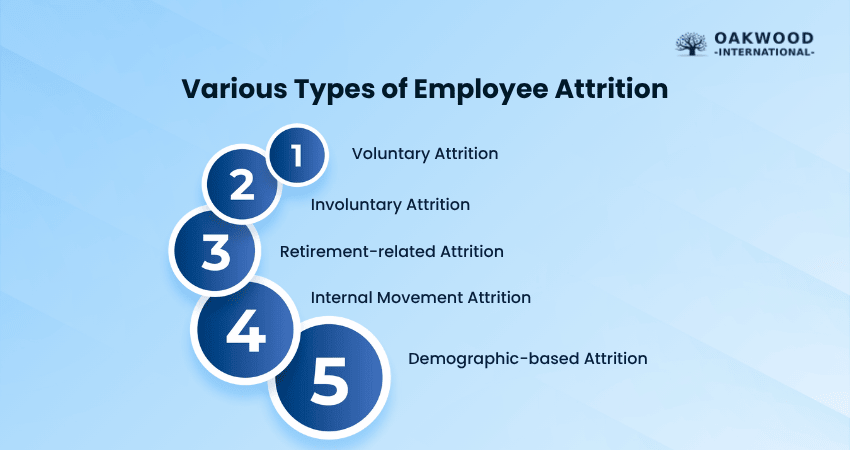
1. Voluntary Attrition
This happens when employees choose to leave the organisation, often for better opportunities, personal reasons, or dissatisfaction with their current role.
Reflects employee sentiment toward the company
May indicate issues with leadership, culture, or engagement
Offers valuable feedback for organisational improvement
2. Involuntary Attrition
In this case, the employer initiates the separation due to performance issues, misconduct, or organisational restructuring.
Driven by business needs or employee performance
Can negatively impact team morale if not handled sensitively
Requires transparent communication and fair processes
3. Retirement-related Attrition
Employees exit the workforce upon reaching retirement age or personal milestones. While expected, it requires proactive planning.
Predictable and manageable with proper planning
May create skill or leadership gaps
Calls for succession planning and knowledge transfer
4. Internal Movement Attrition
Occurs when employees move to new roles within the same organisation. While overall headcount remains, it creates internal vacancies.
Reflects positive career development and internal mobility
Leaves behind roles that need backfilling
Requires training for both outgoing and incoming employees
5. Demographic-based Attrition
Patterns of attrition among specific demographic groups (e.g., age, gender, ethnicity) may reveal underlying workplace inequalities.
Highlights potential diversity and inclusion challenges
Encourages equity-focused retention strategies
Supports a more inclusive and fair workplace culture
Plan with precision, win with vision. Join our Workforce Resource Planning Training and make your staffing strategy truly golden.
What are the Common Causes of Employee Attrition?
Employee Attrition is caused by internal factors and external influences, including changing expectations. Understanding these helps organisations reduce turnover. Here are common reasons:
1. Voluntary Employee Departures
Employees resign for better career prospects, compensation, or personal goals. Discontent with leadership or a lack of growth opportunities also influences their decision. These exits often reflect deeper cultural issues, and supporting growth can improve retention.
2. Organisational Restructuring
Restructuring can make roles obsolete, leading to layoffs or voluntary exits. This creates instability and lowers morale. Involving teams in transitions helps retain trust and commitment.
3. Labour Market Trends and Demographics
Generational shifts influence retention, with younger professionals prioritising flexibility and older staff leaving for lifestyle reasons. Understanding these preferences helps build adaptive work environments.
4. Advancements in Technology
New technologies may replace human tasks or require new skill sets, leading to job displacement. Employees unable to adapt may feel left behind. Offering upskilling opportunities and continuous learning can reduce attrition.
5. Business Process Outsourcing
Outsourcing functions to third-party providers can impact departments like support or payroll. While improving efficiency, it can lower morale. Transparency and fairness during transitions help reduce resentment.
6. Financial Constraints
Cost-saving measures, like staff cuts, benefit reductions, or budget constraints, can lead to dissatisfaction and higher voluntary exits. Honest communication and support help build loyalty and maintain trust during these changes.
7. Changes in Strategic Direction
Shifts in business priorities may lead to redundant roles, causing uncertainty, exclusion, or disengagement. Clear communication, transparency, and an inclusive approach help retain key talent and maintain morale during transitions.
What are the Four Key Factors Influencing Attrition?
Employee Attrition is rarely caused by one factor; it’s usually a mix of personal, professional, and organisational influences. Understanding these factors helps HR teams address issues before they lead to exits. Here are the four key factors:
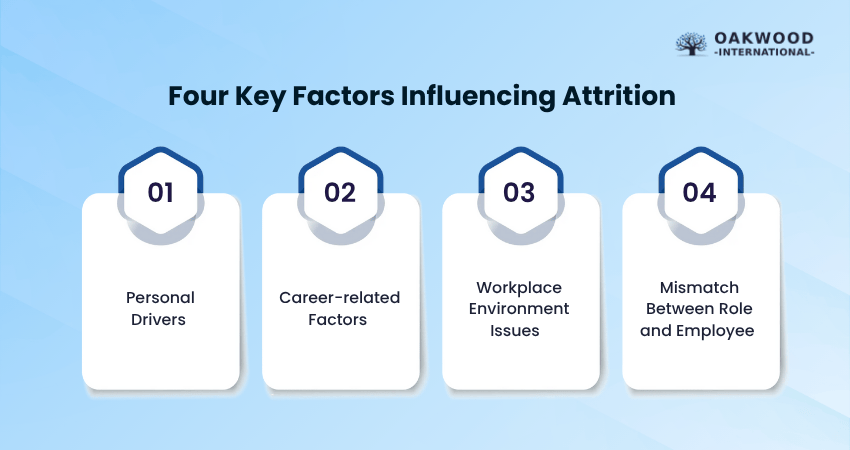
1. Personal Drivers
Life events like relocation or health issues can cause attrition
Personal priorities may outweigh work commitments
Flexibility and early support reduce turnover
Remote work options help employees balance personal and professional life
2. Career-related Factors
Lack of growth, low pay, or unclear goals cause dissatisfaction
Employees seek advancement and recognition
Development plans and mentorship improve retention
Employees leave when they feel their career aspirations are ignored
3. Workplace Environment Issues
Poor leadership and stress lead to disengagement
A toxic work environment drives employees away
Transparent communication and respect boost morale
Employees leave when they feel unsupported or undervalued by management
4. Mismatch Between Role and Employee
Skill-job misalignment causes frustration
Unclear job expectations lead to dissatisfaction
Regular role assessments and feedback improve alignment
Employees are more likely to stay when their role matches their strengths and interests
Attract the best, beat the rest. Dive into our Talent Acquisition Training and build an A‑team that stands supreme!
What Does Employee Attrition Rate Mean?
Employee Attrition rate is the proportion of staff who leave a company within a certain timeframe and whose roles remain vacant. It reflects a permanent reduction in headcount rather than a one-for-one replacement. This figure can result from retirements, resignations, internal moves, or dismissals.
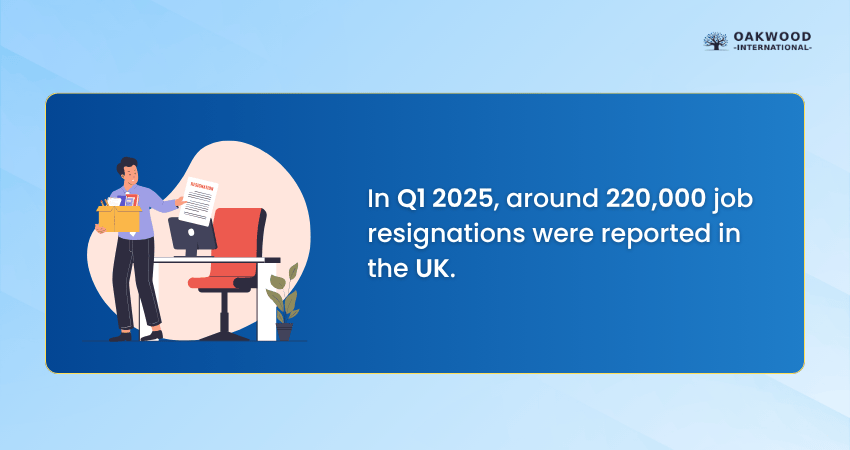
Tracking this rate helps organisations evaluate workforce stability and long-term planning. A rising attrition rate may point to cultural problems, disengagement, or leadership gaps. Understanding these patterns allows companies to make smarter decisions about Talent Management and team structure.
Steps to Calculate the Employee Attrition Rate
Understanding how to calculate the Employee Attrition rate helps organisations measure workforce changes over time. It offers valuable insight into how many employees are leaving and whether the business is maintaining long-term staffing levels. Here's a simple way to calculate it:
1. Choose a Specific Timeframe: Decide on the period you want to analyse, such as a month, quarter, or year.
2. Find the Average Number of Employees: Add the number of employees at the start and end of the period, then divide by two.
3. Count the Total Number of Exits: Identify how many employees left the organisation during the selected timeframe.
4. Apply the Formula: Use the formula:
Attrition Rate = (Number of Leavers ÷ Average Number of Employees) × 100
5. Analyse the Result: Compare the rate with industry benchmarks or past periods to assess trends and make improvements.
Strategies to Reduce Attrition and Strengthen Company Culture
Reducing staff turnover begins with creating a supportive and respectful environment. A healthy culture encourages people to stay, grow, and give their best every day. Strong leadership, clarity, and purpose contribute to deeper commitment across the board. So, get started by knowing some of the strategies given below:
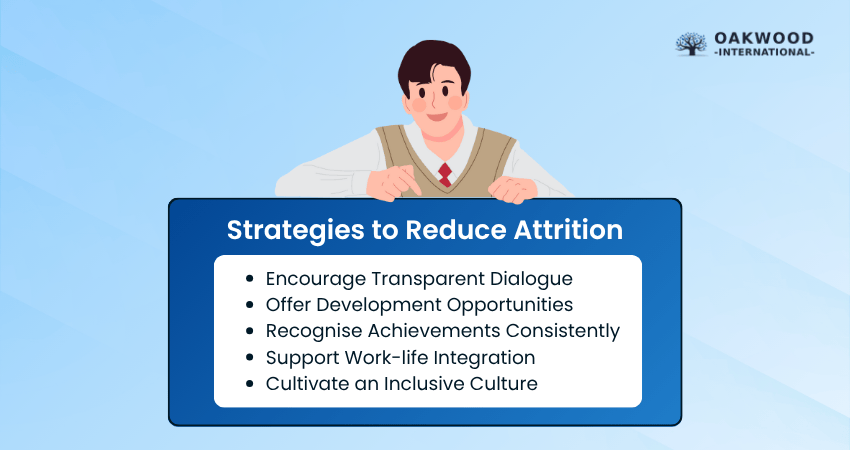
1. Encourage Transparent Dialogue: Regular conversations build trust and minimise confusion during change or growth. People are more likely to stay when they feel heard.
2. Offer Development Opportunities: Help employees sharpen their skills and learn new ones through structured programmes. Growth pathways show that the organisation values long-term potential.
3. Recognise Achievements Consistently: Acknowledgement can be simple yet powerful, from team shoutouts to career milestones. Appreciation helps boost morale across all levels.
4. Support Work-life Integration: Providing adaptable schedules allows individuals to meet both personal and professional needs. Autonomy in how people work leads to higher satisfaction.
5. Cultivate an Inclusive Culture: Ensure everyone feels welcome, respected, and supported regardless of background. Diversity brings new ideas and drives innovation.
Conclusion
Employee Attrition significantly impacts organisational growth and stability. By identifying its causes, types, and influencing factors, businesses can create strategies to retain talent. Fostering a supportive work environment and offering development opportunities are key to reducing attrition. Ensuring work-life balance also plays a crucial role in enhancing employee satisfaction and promoting long-term success.
Set goals right, review with insight. Register for our Performance Appraisal Training and turn feedback into fuel for career flight!


 Back
Back



 Back to Catagories
Back to Catagories





 + 44 7452 122728
+ 44 7452 122728










